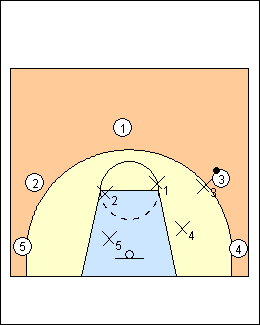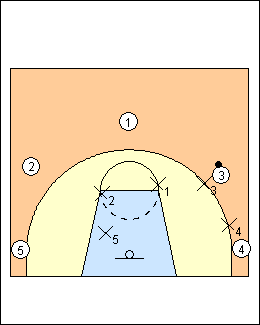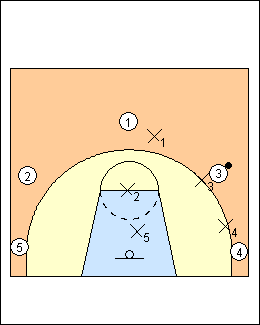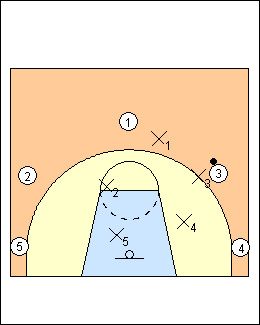Basic halfcourt man defences
 | 1 This is a summary of four halfcourt defensive systems, with pros and cons. In all cases, there is ball pressure and the goals are to keep the ball out of the paint, contest all shots, and allow no second shots. a) Gap Defenders one perimeter pass from the ball play in the gap (sag), help and recover on dribble penetration, but must be able to get to the ball on a pass to their man and contest a shot. Gap defence is good against dribble penetration and outside shooting (quicker close-outs), but does not dictate what the offence will do, or necessarily apply enough pressure to come from behind, especially if there is no shot clock. Options - force ballhandlers to the middle (Jack Bennett), the outside (Kevin O'Neill), or play the ball straight up (Allison McNeill) - off-ball defenders are in an open stance, or closed (Dick Bennett, Scott Clark) - help defenders (two or more passes from the ball) have one foot in the lane, two feet in the lane, or are on the midline (O'Neill). Dick Bennett - only the on-ball defender goes outside the pack-line 16 feet from the basket (except on a dead ball, deny), so there is no help move, only recovery. Use a closed stance for quicker close-outs. Don't give up baseline penetration. Jack Bennett - if the ball is forced toward a gap defender, weakside defenders don't have to help as much, so they have one foot in the lane, and are a little quicker on a skip pass. Kevin O'Neill - when in doubt, recover to the help, get to the midline. Deny to the arc. Defend the ball on the wing with a no-middle but no paint stance, feet parallel to the sideline. It's always one-pass help, if help has to come from two passes away there's a wide-open three or a dunk. Trap a baseline drive outside the paint, all defenders recover to their own on a pass out. Scott Clark - deny to the arc, all off-ball defenders are in a closed stance so as to stunt (open) on the first dribble, help defenders have both feet in the paint when the ball is below the foul line. Allison McNeill - defending a player one pass from the ball be two steps to the ball and one step off the line, two (or more) passes away have one foot in the lane if the ball is above the foul line, and two feet in the lane if the ball is below the foul line. Don't help off the wing, hedge and recover.  |
 | 2 b) Ball-line Deny penetrating passes, gap on non-penetrating passes (retreat to ball level). Ball-line defence denies penetrating passes, which sounds good, but that means denying passes to the wings when the ball is out top, and not denying the pass out top when the ball is on the wing. Most teams want the ball out of the middle. Tubby Smith - deny defenders are on the line, up the line in an open stance with both hands up. With the ball above the foul line, weakside defenders should be on the midline (but they never get there). Force the ballhandler sideline above the foul line and to the corner below.  |
 | 3 c) Pressure Deny all attackers one pass from the ball, on the line, up the line. Trap baseline penetration. Full denial tries to shut down offensive passing, but is vulnerable to backcuts and dribble penetration. It may be needed to come from behind. Denying the wing-entry pass keeps the ball in the middle, unless the defenders are not really denying the pass, just pushing it out so it has to be going away from the basket (Huggins). Options - force the ball sideline/baseline, or play it straight up (Duke) - deny defenders help and recover (Tar Heels) or stunt and recover (Florida, Mavs, Huggins) - help defenders are in a closed stance (Florida, Huggins) or open stance (Tar Heels) - help defenders are on the midline (Florida, Huggins) or have at least one foot in the lane (Tar Heels). Florida - keep the ball out of the middle in the backcourt, off-ball defenders are in a closed position with ballside finger tips on a rope between their man and the ball, helpside defenders straddle the midline. Stunt one pass away, don't help and recover. Bob Huggins - force the ballhandler baseline, all off-ball defenders are between the ball and their man, up the line in a closed stance, help defenders are on the midline. On dribble penetration, help is in line with ball and man, not allowing a direct pass. Avery Johnson - out front is the contain area, don't force the dribbler, contain him. Force baseline below the foul line. Deny one pass away, don't help (suck in) from the corner, stay home, but may bluff and recover. Roy Williams - one pass away, deny with a hand in the passing lane. always help if you have to decide between deny and help. Be in a help position more than one pass from the ball, with at least one foot in the lane. Ken Shields - X1 must extend to prevent quick ball reversal, he does not help on middle penetration by 2. The low weakside defender must be ballside if the ball is below the foul line and there is no strongside low post. Bob Hurley - with the ball out top we're not trying to steal the pass to the wing because it's our objective to get the ball out of the middle of the floor to the sideline. We're up the line but not in the passing lane, supporting the on-ball defender (early help, but recover to your man when the ballhandler's non-dribbling hand comes up to the ball). On a pass to the wing, the on-ball defender makes a power step by jumping into the passing lane to deny a direct pass back. Dick Bennett - push (pressure) defence is based on the idea of interrupting motion offence, don't let them pass and catch. However, the game is now more north-south than east-west (motion), players try to get into the paint, drive and kick for 3s. Pack (gap) defence really makes it hard to get the ball into the paint. He had success getting into "push" (pressure) defence when the ball is on a side (force baseline, deny reversal). X1's job would be to eliminate ball reversal.  |
 | 4 d) Forcing left Force ballhandlers to their left hand, gap on a pass to the attacking left, deny a pass to the right. Most players are much less effective dribbling and passing to their non-dominant side. Gap and deny defenders help and recover on dribble penetration. Forcing left tries to dictate what the offence will do, with full denial right but allowing reversal passes left, promoting the ball to the left wing then locking it in (trap a baseline drive). Option - deny ball reversal to the right only to one step beyond the 3-point line. |
This page was made with Basketball playbook from Jes-Soft